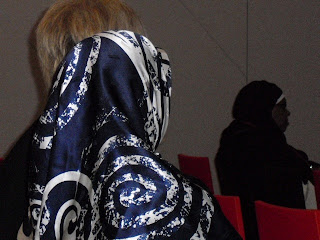New Thought News Service
Mention Scientology and just see how long it takes for someone to chime in with references to well-funded cults, aliens and the mother ship and celebrities jumping on couches.
At the Parliament of World Religions this week, Scientology got equal time.
Rev. Bob Adams, vice president of the Church of Scientology International, discussed the 55-year-old tradition, which is a presence in 165 countries and operates a publishing house. Scientology also maintains several offshoot foundations that work toward a drug-free world, support a prison ministry and run educational programs that help challenged students learn.
Mention Scientology and just see how long it takes for someone to chime in with references to well-funded cults, aliens and the mother ship and celebrities jumping on couches.
At the Parliament of World Religions this week, Scientology got equal time.
Rev. Bob Adams, vice president of the Church of Scientology International, discussed the 55-year-old tradition, which is a presence in 165 countries and operates a publishing house. Scientology also maintains several offshoot foundations that work toward a drug-free world, support a prison ministry and run educational programs that help challenged students learn.
Adams described a practical metaphysics based on the idea that each person has a primary urge to survive and will do so at the highest level he or she is capable of. Scientology rates eight levels of functioning, which range from being concerned solely with one's personal survival all the way up to the survival of consciousness as a whole.
Although people often function from the level of reactive mind, which might also be described as ego, they are actually spritual beings with much higher capabilities and levels of experience available, he told his audience. In Scientology, the ideal, or spiritual self, is the "thetan," derived from the Greek letter, theta.
L. Ron Hubbard, founder of Scientology and the theory of dianetics in the 1950s, authored many of the textbooks used by Scientologists. Best known as a writer of science fiction, he was also an engineer, with an engineer's pragmatic outlook, Adams noted.
Although people often function from the level of reactive mind, which might also be described as ego, they are actually spritual beings with much higher capabilities and levels of experience available, he told his audience. In Scientology, the ideal, or spiritual self, is the "thetan," derived from the Greek letter, theta.
L. Ron Hubbard, founder of Scientology and the theory of dianetics in the 1950s, authored many of the textbooks used by Scientologists. Best known as a writer of science fiction, he was also an engineer, with an engineer's pragmatic outlook, Adams noted.
Adams was not at the Parliament to address Scientology's public relations questions. Instead, with humor and a definite sense of pride, he discussed a worldwide religious movement that has positioned itself as "an applied religious philosophy which offers an exact route through which anyone can regain the truth and simplicity of his spiritual self."












